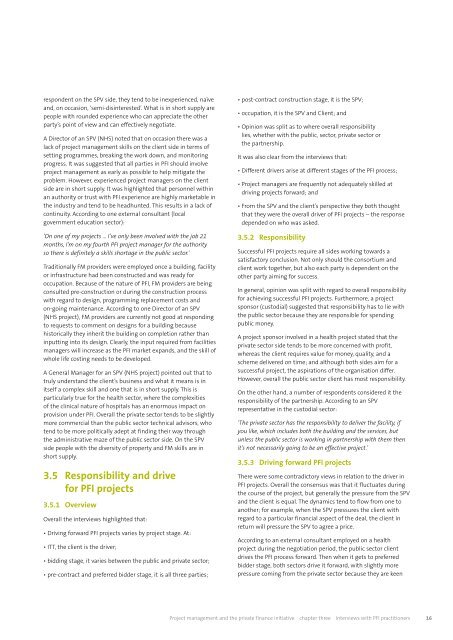Project management and the private finance initiative
Project management and the private finance initiative
Project management and the private finance initiative
You also want an ePaper? Increase the reach of your titles
YUMPU automatically turns print PDFs into web optimized ePapers that Google loves.
espondent on <strong>the</strong> SPV side, <strong>the</strong>y tend to be inexperienced, naïve<br />
<strong>and</strong>, on occasion, ‘semi-disinterested’. What is in short supply are<br />
people with rounded experience who can appreciate <strong>the</strong> o<strong>the</strong>r<br />
party’s point of view <strong>and</strong> can effectively negotiate.<br />
A Director of an SPV (NHS) noted that on occasion <strong>the</strong>re was a<br />
lack of project <strong>management</strong> skills on <strong>the</strong> client side in terms of<br />
setting programmes, breaking <strong>the</strong> work down, <strong>and</strong> monitoring<br />
progress. It was suggested that all parties in PFI should involve<br />
project <strong>management</strong> as early as possible to help mitigate <strong>the</strong><br />
problem. However, experienced project managers on <strong>the</strong> client<br />
side are in short supply. It was highlighted that personnel within<br />
an authority or trust with PFI experience are highly marketable in<br />
<strong>the</strong> industry <strong>and</strong> tend to be headhunted. This results in a lack of<br />
continuity. According to one external consultant (local<br />
government education sector):<br />
‘On one of my projects … I’ve only been involved with <strong>the</strong> job 21<br />
months, I’m on my fourth PFI project manager for <strong>the</strong> authority<br />
so <strong>the</strong>re is definitely a skills shortage in <strong>the</strong> public sector.’<br />
Traditionally FM providers were employed once a building, facility<br />
or infrastructure had been constructed <strong>and</strong> was ready for<br />
occupation. Because of <strong>the</strong> nature of PFI, FM providers are being<br />
consulted pre-construction or during <strong>the</strong> construction process<br />
with regard to design, programming replacement costs <strong>and</strong><br />
on-going maintenance. According to one Director of an SPV<br />
(NHS project), FM providers are currently not good at responding<br />
to requests to comment on designs for a building because<br />
historically <strong>the</strong>y inherit <strong>the</strong> building on completion ra<strong>the</strong>r than<br />
inputting into its design. Clearly, <strong>the</strong> input required from facilities<br />
managers will increase as <strong>the</strong> PFI market exp<strong>and</strong>s, <strong>and</strong> <strong>the</strong> skill of<br />
whole life costing needs to be developed.<br />
A General Manager for an SPV (NHS project) pointed out that to<br />
truly underst<strong>and</strong> <strong>the</strong> client’s business <strong>and</strong> what it means is in<br />
itself a complex skill <strong>and</strong> one that is in short supply. This is<br />
particularly true for <strong>the</strong> health sector, where <strong>the</strong> complexities<br />
of <strong>the</strong> clinical nature of hospitals has an enormous impact on<br />
provision under PFI. Overall <strong>the</strong> <strong>private</strong> sector tends to be slightly<br />
more commercial than <strong>the</strong> public sector technical advisors, who<br />
tend to be more politically adept at finding <strong>the</strong>ir way through<br />
<strong>the</strong> administrative maze of <strong>the</strong> public sector side. On <strong>the</strong> SPV<br />
side people with <strong>the</strong> diversity of property <strong>and</strong> FM skills are in<br />
short supply.<br />
3.5 Responsibility <strong>and</strong> drive<br />
for PFI projects<br />
3.5.1 Overview<br />
Overall <strong>the</strong> interviews highlighted that:<br />
• Driving forward PFI projects varies by project stage. At:<br />
• ITT, <strong>the</strong> client is <strong>the</strong> driver;<br />
• bidding stage, it varies between <strong>the</strong> public <strong>and</strong> <strong>private</strong> sector;<br />
• pre-contract <strong>and</strong> preferred bidder stage, it is all three parties;<br />
• post-contract construction stage, it is <strong>the</strong> SPV;<br />
• occupation, it is <strong>the</strong> SPV <strong>and</strong> Client; <strong>and</strong><br />
• Opinion was split as to where overall responsibility<br />
lies, whe<strong>the</strong>r with <strong>the</strong> public, sector, <strong>private</strong> sector or<br />
<strong>the</strong> partnership.<br />
It was also clear from <strong>the</strong> interviews that:<br />
• Different drivers arise at different stages of <strong>the</strong> PFI process;<br />
• <strong>Project</strong> managers are frequently not adequately skilled at<br />
driving projects forward; <strong>and</strong><br />
• From <strong>the</strong> SPV <strong>and</strong> <strong>the</strong> client’s perspective <strong>the</strong>y both thought<br />
that <strong>the</strong>y were <strong>the</strong> overall driver of PFI projects – <strong>the</strong> response<br />
depended on who was asked.<br />
3.5.2 Responsibility<br />
Successful PFI projects require all sides working towards a<br />
satisfactory conclusion. Not only should <strong>the</strong> consortium <strong>and</strong><br />
client work toge<strong>the</strong>r, but also each party is dependent on <strong>the</strong><br />
o<strong>the</strong>r party aiming for success.<br />
In general, opinion was split with regard to overall responsibility<br />
for achieving successful PFI projects. Fur<strong>the</strong>rmore, a project<br />
sponsor (custodial) suggested that responsibility has to lie with<br />
<strong>the</strong> public sector because <strong>the</strong>y are responsible for spending<br />
public money.<br />
A project sponsor involved in a health project stated that <strong>the</strong><br />
<strong>private</strong> sector side tends to be more concerned with profit,<br />
whereas <strong>the</strong> client requires value for money, quality, <strong>and</strong> a<br />
scheme delivered on time; <strong>and</strong> although both sides aim for a<br />
successful project, <strong>the</strong> aspirations of <strong>the</strong> organisation differ.<br />
However, overall <strong>the</strong> public sector client has most responsibility.<br />
On <strong>the</strong> o<strong>the</strong>r h<strong>and</strong>, a number of respondents considered it <strong>the</strong><br />
responsibility of <strong>the</strong> partnership. According to an SPV<br />
representative in <strong>the</strong> custodial sector:<br />
‘The <strong>private</strong> sector has <strong>the</strong> responsibility to deliver <strong>the</strong> facility, if<br />
you like, which includes both <strong>the</strong> building <strong>and</strong> <strong>the</strong> services, but<br />
unless <strong>the</strong> public sector is working in partnership with <strong>the</strong>m <strong>the</strong>n<br />
it’s not necessarily going to be an effective project.’<br />
3.5.3 Driving forward PFI projects<br />
There were some contradictory views in relation to <strong>the</strong> driver in<br />
PFI projects. Overall <strong>the</strong> consensus was that it fluctuates during<br />
<strong>the</strong> course of <strong>the</strong> project, but generally <strong>the</strong> pressure from <strong>the</strong> SPV<br />
<strong>and</strong> <strong>the</strong> client is equal. The dynamics tend to flow from one to<br />
ano<strong>the</strong>r; for example, when <strong>the</strong> SPV pressures <strong>the</strong> client with<br />
regard to a particular financial aspect of <strong>the</strong> deal, <strong>the</strong> client in<br />
return will pressure <strong>the</strong> SPV to agree a price.<br />
According to an external consultant employed on a health<br />
project during <strong>the</strong> negotiation period, <strong>the</strong> public sector client<br />
drives <strong>the</strong> PFI process forward. Then when it gets to preferred<br />
bidder stage, both sectors drive it forward, with slightly more<br />
pressure coming from <strong>the</strong> <strong>private</strong> sector because <strong>the</strong>y are keen<br />
<strong>Project</strong> <strong>management</strong> <strong>and</strong> <strong>the</strong> <strong>private</strong> <strong>finance</strong> <strong>initiative</strong> chapter three Interviews with PFI practitioners<br />
16

















